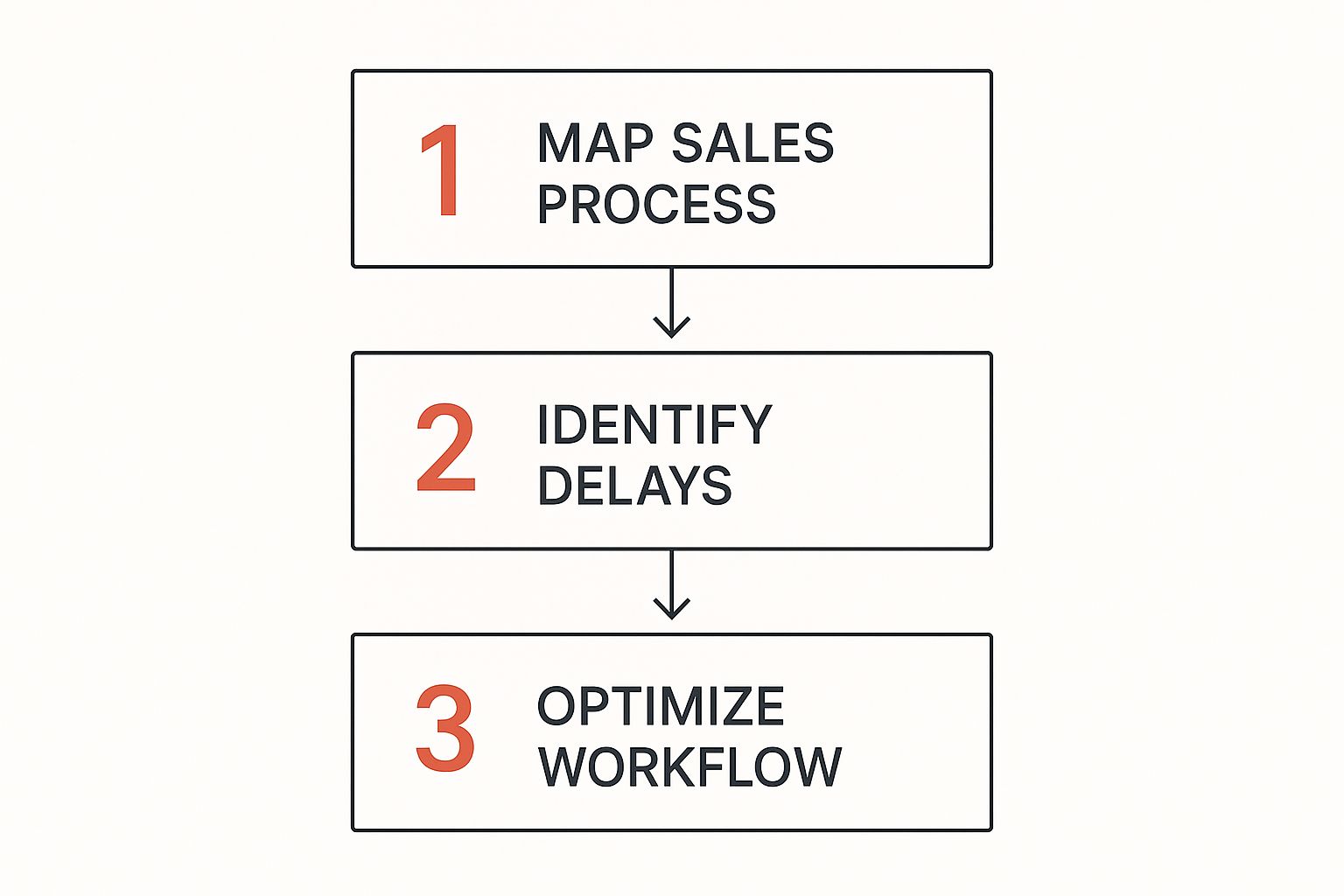If you want to boost your agency's sales productivity, the formula is simple: cut the time spent on non-selling tasks so your team can spend more time building client relationships and closing deals. It's not about working harder. It’s about creating smarter processes, using the right tech, and laser-focusing on the activities that actually move the needle for your agency's growth.
How to Build Your Agency's Sales Productivity Playbook

For a modern agency, getting sales productivity right means turning your sales function from a chaotic, unpredictable cost center into a smooth, reliable revenue engine.
The challenges are real for agencies. We've all seen it: long sales cycles, painfully complex custom proposals, and a mountain of admin work that pulls your best people away from what they're supposed to be doing—selling your agency's services. It’s no surprise that many agency salespeople spend less than 40% of their time on actual revenue-generating activities.
You can't fix this with generic advice or a "try harder" mentality. A systematic approach is the only way to build sustainable growth for your agency. This guide isn't about abstract theories; it’s a clear roadmap built from real-world agency experience to fix the specific friction points you face every day.
To get started, let's break down the framework for building a high-performing agency sales operation. We've organized this playbook around four core concepts that serve as the foundation for everything else.
By building on these pillars, you create a system where productivity gains aren't just a one-time project, but the natural outcome of a well-oiled sales machine.
Every change you make, from adopting a new tool to tweaking a workflow, should align with one of these pillars. It’s how you ensure every effort is deliberate and impactful.
This playbook will walk you through diagnosing your team's biggest inefficiencies, putting the right technology to work, and fostering a culture that transforms your sales team into your agency's most valuable strategic asset.
First up, let's find the hidden bottlenecks that are secretly holding your agency back.
Step 1: Pinpoint the Hidden Bottlenecks in Your Agency Sales Process
Before you can boost sales productivity, you have to figure out what's slowing your agency down in the first place. It’s almost never one single, glaring issue. Instead, it's usually a series of small friction points that quietly pile up, leading to a ton of wasted time and effort.
The only way to find them is to map out your entire sales journey, from the very first touchpoint with a prospect all the way to a signed contract.
You've got to ask the hard questions. Where are our promising proposals going to die? How many hours are our account execs losing to tedious, non-selling tasks like CRM updates or chasing internal approvals? A brutally honest audit is the only way to see what's really happening in the trenches.
How to Audit Your Agency's Sales Workflow from Lead to Close
Get visual and map out every single stage of your sales process. I'm not just talking about the neat little stages you have set up in your CRM. I mean what your team actually does every single day.
A typical agency workflow probably looks something like this:
- Initial lead qualification
- A discovery call
- Proposal creation
- The big presentation
- Negotiation
- Finally, closing the deal
With that map laid out, it's time to talk to your sales team. Don't just ask them, "Is this process efficient?" That's a surefire way to get a generic "yes." Dig deeper with targeted questions about each stage to uncover the real time-sinks:
- Discovery Calls: "How long does it really take you to prep for a discovery call? What info is always a pain to track down?"
- Proposal Building: "On average, how many hours are you sinking into building a custom proposal from scratch?"
- Follow-ups: "Be honest, how many emails or calls does it usually take to get a pulse after you send a proposal?"
- Handoffs: "Where does everything get clunky when you hand a new client over to the project management team?"
This approach forces you to stop looking at symptoms and start digging for the root causes of the drag.
You might think the problem is that deals are taking too long to close. But a good audit could reveal the real culprit is a two-week internal delay just to get custom proposals approved. Fixing the symptom won't do a thing; you have to fix the broken process.
Let's look at a real-world example. A digital marketing agency I know was pulling their hair out over a painfully long sales cycle. When they mapped everything out, they were shocked to discover their sales reps were spending nearly 40% of their week building hyper-customized proposals for every single qualified lead. Each one needed fresh case studies, custom graphics, and sign-off from three different departments.
This one bottleneck was absolutely crushing their productivity.
The fix? They developed a modular proposal system with pre-approved templates for different service tiers. That simple change cut their proposal creation time by more than half. It freed up their team to focus on what they do best: building relationships and closing more deals, faster.
This visual breaks down a simple framework for this diagnostic process.

As the infographic shows, it’s a clear, repeatable flow: map what you're doing now, pinpoint the exact delays, and then roll out targeted fixes.
How to Identify Specific Delays and Calculate Their Impact
With your process map in hand, it's time to put some numbers to the delays. Use a mix of CRM data and your team's feedback to estimate the time burned at each stage. You're hunting for the outliers—the steps that eat up a ridiculous amount of time for the value they deliver.
Make sure you identify both active delays (like reps spending hours on manual data entry) and passive delays (like waiting days for a manager's signature). Both are equally toxic to sales momentum.
For a deeper dive, it's worth exploring proven strategies to improve your B2B sales process. Once you’ve nailed down your top 2-3 bottlenecks, you can rank them by their impact on revenue and how difficult they'll be to fix. This is how you move from guessing what’s wrong to knowing exactly where to focus your energy for the biggest payoff.
Step 2: Use Smart Automation to Give Your Agency Team More Selling Time

Repetitive admin work is the silent killer of your agency's sales productivity. Every single hour your team spends wrestling with manual data entry, scheduling, or sending generic follow-ups is an hour they aren't spending on the high-value conversations that actually close deals.
This isn’t about replacing your salespeople with robots. Not even close. It's about giving them an advantage—letting them focus on what they do best, like building relationships and negotiating, while technology handles the tedious background noise. Smart automation is a force multiplier for your existing talent.
For agencies, these opportunities are practically hiding in plain sight. Think about automating the follow-up sequence after a proposal goes out or setting up internal alerts for when a prospect revisits your pricing page. These small wins add up to massive gains.
How to Identify High-Impact Automation Opportunities in Your Agency
First things first, you need to pinpoint which tasks are practically begging to be automated. Look for the repetitive, low-creativity work that bogs down your agency's team every single day. These are your prime candidates.
Here are a few classic examples I've seen work wonders in agencies:
- Automated Lead Nurturing: Set up email sequences that automatically drip-feed new leads with relevant case studies and insights. This warms them up so that by the time a salesperson makes contact, the prospect is already familiar with your value.
- Proposal Follow-ups: Create a simple workflow that sends a gentle reminder three days after a proposal is sent, and maybe another one a week later if you haven't heard back. No more deals falling through the cracks because someone got busy.
- Internal Deal Alerts: Have your CRM fire off a Slack notification to the relevant account exec and manager when a deal moves to a new stage. It keeps everyone in the loop without clogging up inboxes.
This isn’t just about being faster; it's about being consistent. Automation ensures every lead gets the same professional, timely follow-up, no matter how chaotic things get. If you want to take it a step further, exploring how advanced AI automation services can give your agency a serious competitive edge.
How to Empower Your Agency Team with AI-Driven Tools
Beyond simple workflows, AI is opening up some seriously powerful new ways to boost sales productivity. One of the biggest game-changers for agencies is taming the firehose of information from client discovery calls.
Sales teams that lean into automation see a dramatic rise in productivity. It can free up about 20% of a sales professional’s time—hours previously lost to mind-numbing tasks. In fact, high-performing organizations are twice as likely to describe their processes as highly automated.
Tools like Scribbl are perfect for this. They can automatically transcribe and summarize those critical conversations, pulling out key action items, client pain points, and even potential upsell opportunities. This frees your team from frantic note-taking, letting them be fully present and strategic during the call.
Instead of spending an hour after the meeting trying to piece together scribbled notes, they get an instant, actionable summary. This also creates a single source of truth for every client interaction—invaluable for a smooth handoff to your account and project management teams.
How to Measure the Impact of Your Automation Efforts
Putting automation in place is only half the job. You have to measure its impact to know what's actually working and where you should double down.
Start by tracking a few key metrics before and after you roll out a new automated process.
By focusing on these tangible outcomes, you can build a rock-solid business case for investing more in the tools and processes that will take your agency's sales performance to the next level.
Step 3: Turn Your CRM into a Predictive Agency Sales Engine
For way too many agencies, the CRM is just a glorified digital rolodex. It’s a place to dump contacts and maybe, if you're feeling ambitious, log a few notes. It's time to stop treating this powerful tool like a passive database and start running it like the central nervous system of your sales operation.
A properly tuned CRM does more than just store data. It becomes a predictive engine that can seriously boost your agency's productivity. The trick is to track the metrics that actually matter for an agency’s unique, project-based sales cycle. Forget the generic fields and start customizing.
How to Build Agency Dashboards That Reveal Actionable Insights
Generic dashboards won't cut it. To get a real pulse on your agency pipeline, you need to see the metrics that define agency success in real-time. This means building custom dashboards that surface critical insights at a glance, not burying them.
Your main sales dashboard should answer specific, strategic questions, not just show you a list of deals. Think about creating views that reveal:
- Pipeline Velocity: How fast are deals moving from proposal to closed-won? This will immediately flag any bottlenecks in your process.
- Lead Source Performance: Are referrals, content, or outbound efforts bringing in the most valuable clients? It's not about the number of leads, but the quality.
- At-Risk Deal Alerts: Can you set up a flag for deals that have been sitting in one stage for too long? This is your cue to jump in and get things moving.
Imagine your dashboard shows that clients from the tech industry have a 30% shorter sales cycle and a higher average project value. That's not just an interesting fact; it’s a bright, flashing sign telling you exactly where to focus your prospecting efforts. This is how you start making data-driven moves that directly impact the bottom line.
The real power of a CRM isn't in what it stores, but in what it reveals. When you configure it to track the right agency metrics, you stop reacting to the past and start predicting the future.
This isn't just theory; the numbers back it up. A staggering 94% of businesses report a measurable jump in sales productivity after getting their CRM systems in order. These platforms help teams see up to a 34% rise in productivity and can shorten sales cycles by as much as 8–14%. The latest sales statistics on Spotio.com paint a very clear picture of just how impactful this can be.
How to Use Your CRM Data for Accurate Agency Revenue Forecasting
Forecasting is a massive headache for most agencies, but your CRM data holds the key to getting it right. By analyzing your historical deal progression, you can build a far more reliable forecasting model than just guessing.
Start by looking at your win rates from each stage of the pipeline. If you know from past experience that 70% of deals that reach the proposal stage eventually close, you can apply that probability to your current pipeline. This weighted forecast gives you a much more realistic picture of future revenue than just wishfully adding up the total value of all open deals.
This gets even better when you start integrating your tools. Connecting your CRM to the other software in your tech stack creates a seamless flow of information that makes your data richer and automates the grunt work. If you want to dive deeper into how this works, check out this guide on what is CRM integration.
How to Automate Repetitive CRM Tasks Your Team Hates
Let’s be honest, the biggest complaint from any sales team is the soul-crushing time spent on manual CRM data entry. This is where automation becomes your secret weapon. You can set up workflows that automatically update deal stages based on specific triggers, like when a proposal is sent from your proposal software or a contract is signed via DocuSign.
Here are a few high-impact automations you can set up for your agency:
- Automatic Task Creation: When a deal moves to a new stage, have the CRM automatically create and assign a follow-up task to the right person. No more "I forgot to follow up."
- Smart Data Enrichment: Use tools that automatically pull in contact and company information, freeing your team from tedious manual research.
- Nudge Reminders: If a deal has gone quiet for a set number of days, trigger an automated reminder for the sales rep to check in.
When you turn your CRM from a manual chore into an automated, predictive engine, you free up your sales team to do what they actually do best: build relationships and close deals. This is the playbook high-performing agencies use to consistently win.
Step 4: Choose and Implement the Right Sales Tech for Your Agency

Investing in new sales tech is exciting. You see the potential, you imagine the productivity gains, and you pull the trigger. But here’s a hard truth many agency leaders learn too late: the tech itself is only half the battle. A shiny new tool is worthless if your team can't—or won't—use it.
The real challenge isn't just buying software; it's closing the gap between a new subscription and genuine, team-wide adoption that actually delivers an ROI. For agencies, this means zeroing in on tools that solve specific, high-friction problems in your sales cycle, like proposal generation, e-signature collection, and client communication tracking.
These tools are built to save time, but they often fall flat without a smart implementation strategy. A successful rollout is less about the technology and much more about your people.
How to Overcome the Biggest Tech Adoption Hurdles
The most common roadblocks to tech adoption are surprisingly human. It's rarely about the software being "bad." More often than not, it comes down to a lack of proper training or budget constraints that prevent that training from happening. Just sending a login link and hoping for the best is a surefire recipe for failure.
Sales technology is absolutely reshaping productivity. In fact, 72% of professionals believe it directly improves their performance. Yet, at the same time, 33% of companies say a lack of training and budget are major obstacles. The solution isn't just to throw more money at the problem, but to invest smarter by prioritizing education right alongside the software itself. You can find more data like this in a great in-depth report on sales statistics from Close.com.
Your investment in technology must be matched by an equal investment in your people. The goal is to empower your team with tools that feel like an advantage, not another chore.
To get it right, you need a game plan that tackles these challenges head-on. This means creating a phased rollout and a continuous training program that empowers your team instead of overwhelming them.
How to Create a Phased Rollout Plan for New Sales Tech
Trying to launch a complex new tool across your entire sales team at once is a classic mistake. It creates chaos, frustrates your top performers, and makes it impossible to gather any meaningful feedback. Trust me, a phased approach is far more effective.
Here’s a simple framework I've seen work time and time again in agencies:
- Start with a Pilot Group: Select a small, diverse group of 2-3 salespeople to be your pioneers. You'll want a mix: include a top performer, a solid mid-tier rep, and even someone who might be a bit tech-skeptical. This gives you a balanced, real-world perspective.
- Focus on One Core Use Case: Don’t try to teach every bell and whistle at once. Identify the single biggest pain point the tool solves—like automating proposal creation—and get the pilot group mastering that one function first.
- Gather Feedback and Iterate: Hold weekly check-ins with your pilot team. What’s working? What’s confusing? Where are they getting stuck? Use their hands-on feedback to refine your training materials and internal best practices before a wider launch.
This method minimizes disruption and lets you build a proven, repeatable process that you can confidently roll out to the rest of the team.
How to Develop a Continuous Training Program That Sticks
One-and-done training sessions just don't stick. For lasting adoption and to truly maximize the value of your tech stack, you need to build a culture of continuous learning.
Here’s a real-world example: one agency I know achieved a 90% adoption rate for a new communication tool by ditching the idea of a single, two-hour webinar. Instead, they built a sustainable program that worked.
Bite-Sized Training Modules: They created a library of short, 3-5 minute video tutorials, each focused on a single feature. This made it ridiculously easy for reps to find quick answers without scrubbing through a long, boring recording.
Appoint Internal 'Tech Champions': The agency identified the most enthusiastic user from their pilot group and officially made them the go-to "tech champion." This person got extra training and was empowered to help their peers, which created an awesome internal support system and took the pressure off managers.
By making training accessible, ongoing, and peer-driven, they turned a potential hurdle into a powerful driver of adoption. The end result? A massive boost in sales productivity.
Step 5: Measure What Matters and Build a High-Performance Agency Culture
Rolling out a new tool or fine-tuning your sales process is just the starting line. The real work—and the real payoff—comes from measuring the impact and building a culture that keeps the momentum going. Without data, you're flying blind. And without a solid culture, even the smartest strategies will fizzle out.
For agencies, this means getting brutally honest about what you're tracking. It’s time to move past feel-good metrics and zero in on the key performance indicators (KPIs) that actually show you the health of your sales engine. We're not just rewarding reps for making the most calls anymore; we're figuring out which specific actions lead to signed contracts and happy, long-term clients.
How to Ditch Vanity Metrics for Agency-Specific KPIs
The first step to improving your sales productivity is making sure you’re even measuring it correctly. It's way too easy to mistake busywork for progress. A rep banging out 100 cold calls a day looks productive, but if none of those dials turn into qualified leads, it's just motion without movement.
Agency sales cycles are unique, and your dashboard needs to reflect that reality.
Here are the KPIs I’d put front and center on any agency sales dashboard:
- Average Sales Cycle Length: How long does it take to get a prospect from that first "hello" to a signed deal? If this number is shrinking, your process tweaks are working. Simple as that.
- Proposal-to-Close Ratio: Of all the proposals you send out, what percentage actually turn into new business? This is a raw look at your proposal quality and your team's follow-up game.
- Client Acquisition Cost (CAC): What's the real cost in sales and marketing dollars to land a new client? Tracking this makes sure your productivity wins are also hitting the bottom line.
- Lead-to-Qualified-Lead Conversion Rate: This shows you if your team is spending their precious time with the right people from the get-go. It's a massive lever for overall efficiency.
Focusing on these numbers gives you a clear, unflinching view of your sales health. It changes the conversation from, "Are we busy?" to, "Are we being effective?"
True productivity isn't about the volume of activity; it's about the velocity of results. When you measure the right things, you empower your team to focus on the actions that genuinely drive revenue for your agency.
How to Create an Environment of Continuous Improvement
Data is a powerful flashlight, but it's a supportive culture that actually gets people to move. A truly high-performing sales team lives in an environment where getting better is the daily standard, not some one-off project. It's about creating a space where people feel safe to try new things, share what's working, and give honest feedback without worrying about getting slapped down.
This kind of culture doesn’t just magically appear—it has to be built, brick by brick, by leadership. It all starts with psychological safety, where your team members know they can ask questions or admit they don't have all the answers.
When reps feel that support, they’re far more likely to find ways to improve their own game and help their teammates level up, too. This sparks a powerful feedback loop that drives sustainable growth for the whole team. Before you can get there, though, you need a solid grasp of how to measure team productivity in a way that feels fair and actually motivating.
4 Practical Strategies for Building a Better Agency Sales Culture
Building this culture requires concrete actions, not just inspirational posters on the wall. Agency leaders can actively shape an environment where productivity thrives by putting a few key practices into motion.
- Run a Weekly "Wins & Learnings" Huddle: Block out 30 minutes every week for the team to share one win and one "learning" (something that didn't go as planned). This makes it okay to fail and helps best practices spread like wildfire.
- Celebrate Process Improvements, Not Just Closed Deals: Did a rep find a genius way to automate a tedious report? Or create a new email template that's getting killer response rates? Shout it from the rooftops. This shows everyone that how you work is just as important as the final number.
- Encourage Peer-to-Peer Coaching: Pair up your seasoned pros with newer reps for regular check-ins. This opens up a natural mentorship channel and lets your top performers lift the entire team.
- Make Feedback a Two-Way Street: Don't just give feedback; actively ask for it. Ask your sales team what they think about your leadership, the process, and the tools. When they see their input is valued—and acted on—they become far more invested in the agency’s success.
By weaving these habits into your weekly rhythm, you transform the culture from one of top-down orders to one of collaborative growth. This foundation, built on clear data and genuine support, is how you turn a temporary productivity boost into a permanent competitive edge for your agency.
Ready to give your agency team a powerful advantage? Scribbl automates the tedious post-meeting tasks that drain hours from your week. From AI-powered summaries and action items to automated CRM updates and proposal generation, Scribbl frees your team to focus on what truly matters—building client relationships and growing your agency. See how much time you can save by visiting https://www.scribbl.co.




